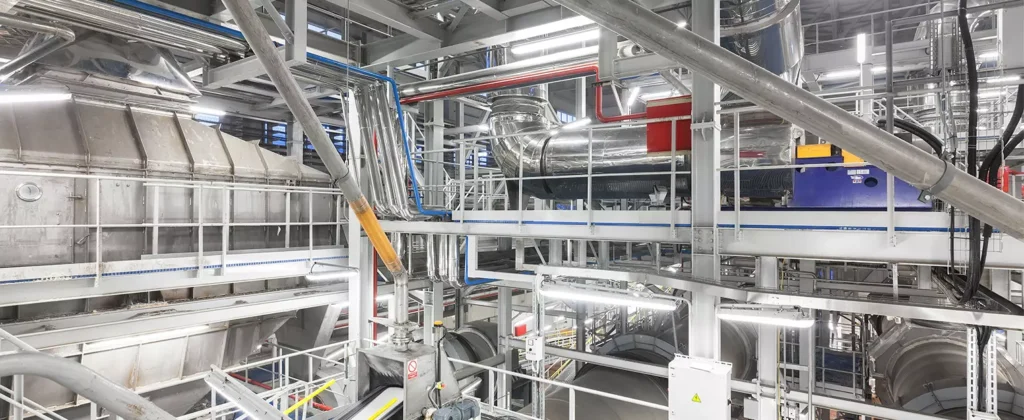CO2 recovery units for industries
The challenge of climate change is intrinsically linked to human-generated carbon dioxide emissions. To address this, we need both strategies to reduce emissions and innovative approaches to recover and reuse CO₂. While emission reduction practices are well-established, the recovery and reuse of CO₂ as a raw material are still in experimental or early stages. However, if these approaches can achieve economies of scale, they will truly embody the principles of a circular economy.
Since decarbonizing certain industrial processes remains challenging, capturing and reusing CO₂ can accelerate the energy transition across the entire production sector. The result is to reduce greenhouse gas emissions and decreased reliance on fossil raw materials.
For example, materials like polyester, polystyrene, and polycarbonate, which are essential in our daily lives, currently rely on benzene and toluene derived from petroleum. However, ongoing research demonstrates that the chemical industry can indeed recover CO₂ and use it as a carbon source for polymer production, ensuring quality and reliability.
Decarbonizing industrial processes is a critical endeavor to combat climate change. Here are some of the key points about this topic:
- Importance of Industrial Decarbonization:
- The industrial sector contributes significantly to global greenhouse gas (GHG) emissions, accounting for about 28% of total emissions in 2014.
- Key industries include cement, steel, ethylene, and ammonia production.
- These sectors are challenging to abate due to their high share of emissions from feedstocks (raw materials) and high-temperature heat.
- Emission Sources in Industrial Processes:
- CO₂ comprises over 90% of direct and indirect GHG emissions from industrial processes.
- Approximately 45% of industry’s CO₂ emissions result from manufacturing:
- Cement (3 Gton CO₂)
- Steel (2.9 Gton CO₂)
- Ammonia (0.5 Gton CO₂)
- Ethylene (0.2 Gton CO₂)
- These emissions come from feedstocks and burning fuel for high-temperature heat.
- Other energy requirements contribute to the remaining emissions.
- Options for Decarbonization:
- Energy Efficiency: Using less energy while maintaining productivity.
- Industrial Electrification: Shifting from fossil fuels to low-carbon electricity.
- Low-Carbon Fuels, Feedstocks, and Energy Sources (LCFFES).
- Carbon Capture, Utilization, and Storage (CCUS).
- Challenges and Opportunities:
- Decarbonizing industry is technically feasible but faces economic hurdles.
- Planning and investments must start early due to long industrial site lifetimes.
- Achieving net-zero emissions while maintaining competitiveness is crucial.
CO2 recovery technology generates CO2 suitable for food and pharmaceutical applications which can be used in many industrial environments where CO2 is a waste product from main processing. The recovered CO2 can represent an additional source of income and be sold, for example, in the food industry and other industries like pharmaceutical industry for the production of micronized particles or APIs.
Here’s how the CO2 recovery process works:
- Raw gas capture: The gas produced by microorganisms during fermentation is captured.
- Purification: The gas is purified to remove alcohol and aerosols.
- Compression: CO2 is compressed to reduce its volume.
- Liquefaction: CO2 is liquefied and stored in cryogenic tanks outside.
- Fuel cell technology: offers an intriguing avenue for CO₂ recovery, especially in the context of co-production. The CO₂ byproduct can then be captured, purified, and utilized by businesses rather than being emitted into the atmosphere. This self-supply of CO₂ ensures consistent pricing, availability, and quality
Benefits of CO2 recovery:
- Reduced production costs: By using recovered CO2, you reduce the costs of purchasing from external suppliers.
- Reduced environmental impact: The overall process becomes more environmentally friendly due to lower emissions and a reduced environmental impact.
- Source of income: The recovered CO2 can be sold to the food industry, used for carbonation of beverages or for the production of dry ice.
Where possible, we can help minimize resource use and recover energy from the heat exchangers or compressor used to help reduce your company’s overall energy costs.

